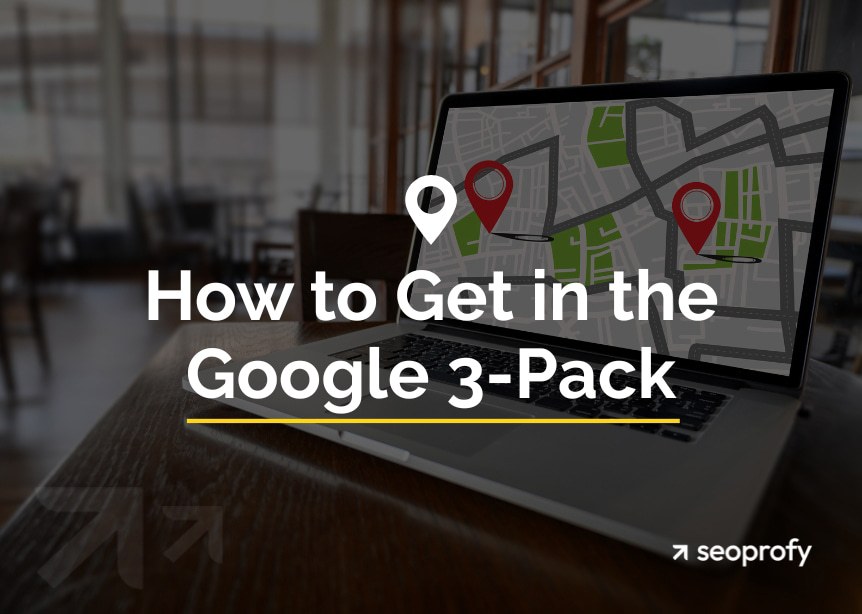How many SEO keywords per page is optimal for your content? It’s a pretty common question in online marketing, but there’s no simple answer that fits all cases.
Too few keywords and search engines might miss your topic focus. Too many and you risk Google penalties. In this expert guide, our team clarifies the optimal density based on different aspects. We also explain why keyword stuffing and so-called cannibalization can be harmful for your rankings, and what other SEO aspects affect your visibility.
- The longer your content, the more room you have to increase your SEO keyword count naturally. For instance, a 3,000-word blog article can seamlessly incorporate over 20 strategic search terms.
- Keyword stuffing hurts your rankings, as Google detects when you use too many search terms.
- The placement matters, too. Include keywords in your title, headings, first paragraph, meta description, and URL.
- Keyword cannibalization happens when multiple pages target the same search term and end up competing against each other.
- While keywords are critical for search visibility, they’re not the only factor that impacts rankings.
The Importance of SEO Keywords
SEO keywords are the words people use when they look for something in search engines. Google algorithms scan billions of pages, looking for matches based on search terms. If your pages contain relevant SEO keywords and if these pages match the context and the user’s intent, Google and other search engines will more likely provide people with your page.
You can choose from multiple SEO tools that can assist you with keyword research. For instance, if you’re interested in leveraging AI for this task, as 37.5% of marketing specialists already do, you can consider Ahrefs’ AI-based Keywords Explorer. It offers numerous ideas for a particular keyword of your choice. Here are the options suggested by this tool on the topic “time tracking tool.”
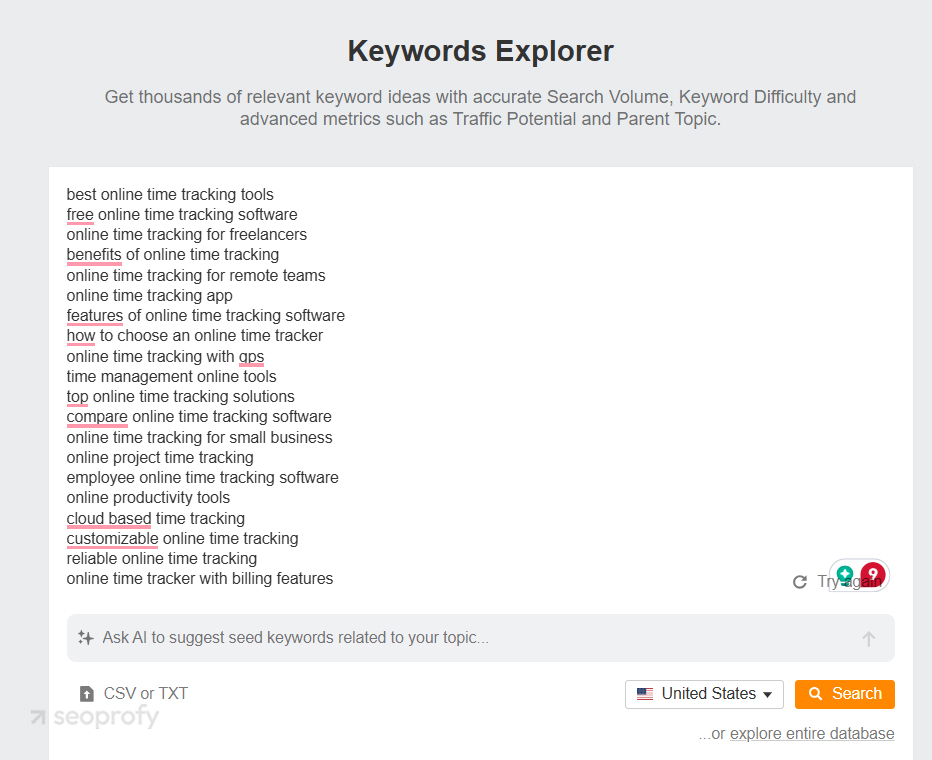
However, not only the presence of specific keywords on your page determines your SEO success. The whole thing is a lot more complicated. When choosing keywords, pay attention to the following factors, too:
- Keyword difficulty (KD): This shows how challenging it will be to rank for a particular term. High-difficulty instances are usually very competitive because many established sites target them. On the other hand, lower-difficulty keywords might be easier to rank for, and they will still bring in relevant traffic.
- Search volume: Queries with high search volume are usually exactly the keywords with high KD, because the most popular terms draw thousands of searches and more visitors, and everyone wants to rank for them.
- Keyword relevancy: This measures how well a target phrase matches your overall topic. Search engines favor pages that not only include the right keywords but also provide content that satisfies users’ requests.
To detect KD and search volume for a specific keyword, you can use the abovementioned Ahrefs:
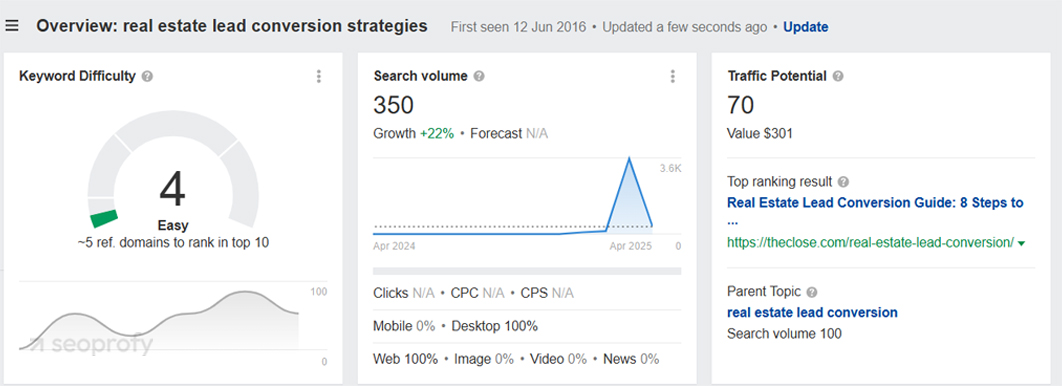
It’s also important to recognize that search engine terms come in different forms. And you should clearly understand these types. This helps you build a more complete SEO strategy that captures various search intents:
- Primary keywords: These are your main focus words, like “running shoes” or “project management software.” They’re short and straightforward. Everyone searches for them, so they get a lot of traffic. Because these clearly describe what your page is about, primary keywords should be emphasized in your titles and headings.
- Secondary keywords: Slightly more detailed, like “comfortable running shoes” or “affordable project management tools.” Not as many people search for these, but they can help attract visitors with more specific needs.
- Long-tail keywords: Very specific phrases, such as “women’s waterproof trail running shoes size 8” or “budget-friendly project tracking software for freelancers.” Fewer people search these exact terms, and they may bring in less traffic overall, but those who do are often very interested and ready to buy.
The Role of LSI Keywords
There are also latent semantic indexing (LSI) keywords. These are closely related terms that add depth to your content. They let search engines understand what your page is about.
To find LSIs for your specific topic, you can also make use of various SEO tools. Just come up with your main topic, like “lead conversion” below, and a tool will provide you with a range of semantically related terms:
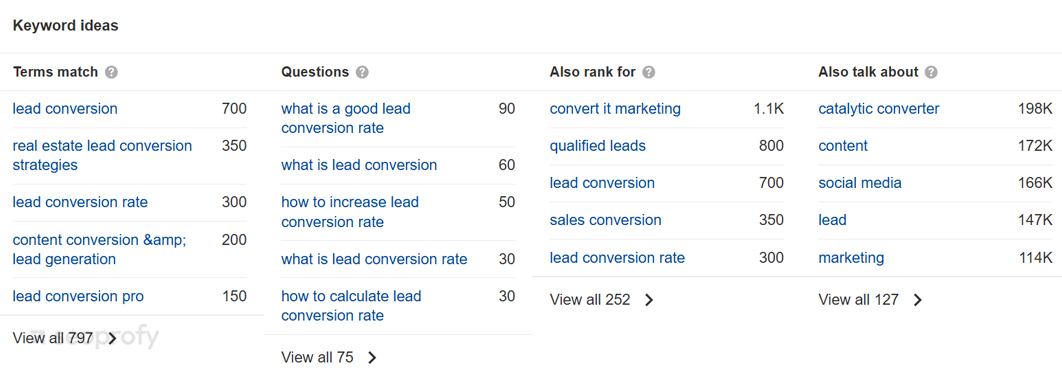
How to Use Keywords? Keyword Density and Keyword Stuffing
Another aspect of success is keyword density — how often your target phrases are used compared to the total words in your content. Find the optimal number of keywords in SEO content, and it will become more readable, and your rankings could rise.
If you’ve ever come across the copy that repeats the same keyword phrase over and over, that’s called keyword stuffing. It occurs when multiple keywords are forced into content so that the overall text sounds awkward and artificial.
Most of the time, this happens by accident. However, whether accidental or not, Google notices such things and can even lower the site’s rankings. If you find yourself in this situation, a professional SEO agency can help you get back on track. Just ensure they offer Google penalty recovery services so that you entrust your website to the right hands.
Here are the examples of keyword stuff that Google disapproves:
- Phone number lists that don’t add value
- Blocks of text that just list city names to try to rank locally
- Too many keywords in SEO content so that they sound unnatural
Here’s what exactly Google means by the latter:

Keep in mind, stuffing keywords even in just one part of your page may negatively affect your ranking. The page might be readable at first, but if one paragraph is full of keywords, it can still cause problems.
A simple way to avoid this is by using synonyms. Google understands that these are related keywords, so it can match searches to your content even if the exact words aren’t the same. This way, you can increase your SEO strategy keyword count, yet you won’t sound repetitive or spammy.
How Many SEO Keywords Should You Use?
So, because stuffing keywords can be risky, how do you find the right balance? You want enough search terms so your page ranks well, but not so many that you get penalized. The truth is, there’s no one-size-fits-all rule. The ideal number of keywords for SEO depends on a few things:
- Page purpose and format: Your homepage mainly tells your brand story and might only need a handful of main ranking terms, say three to five. However, how many keywords should a blog post have? Such a format can naturally include 15 to 30 queries because they cover detailed topics and answer multiple questions.
- Content length: Longer copy tends to handle more keywords. For example, a 500-word page might comfortably include five to seven target phrases without sounding stuffed. Meanwhile, a 3,000-word guide can easily incorporate 20 or more keywords.
- What your competitors in the TOP do: You can also take a look at the pages already ranking high for your main target terms and phrases. Notice how many related queries they use. This will give you a realistic idea of what the standard is in your particular case.
You can also use different tools, like the Side-by-Side SEO Comparison Tool, to check your keyword density and identify the number of keywords for effective SEO. These tools scan your content, display keyword frequency, and show their percentage compared to your total words. Take a look:
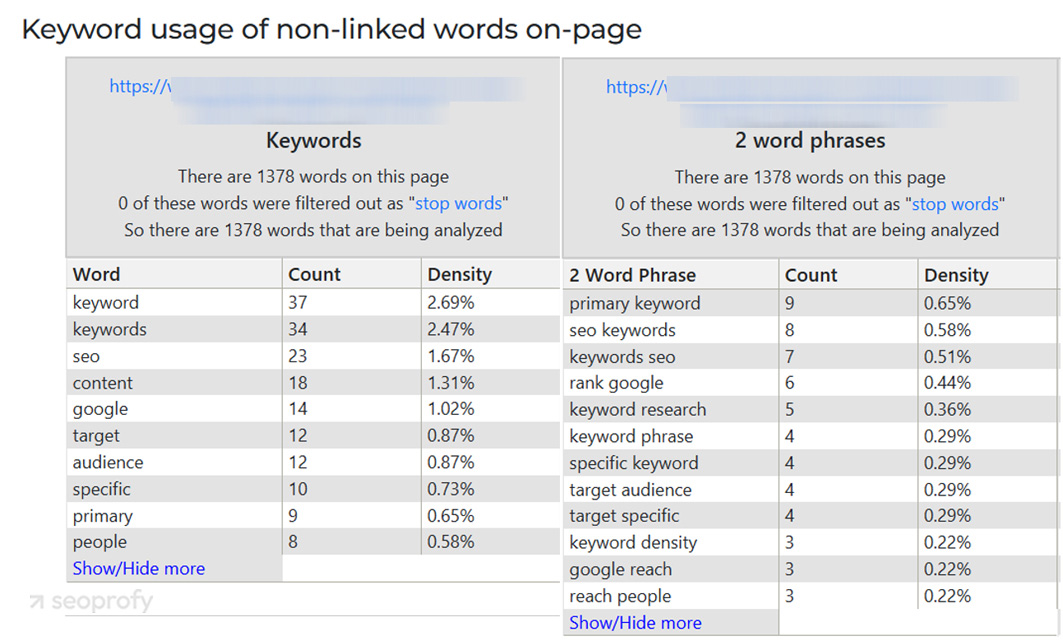
Another tool is Surfer Seo. It displays appropriate ranges for using keywords per page in the following way:
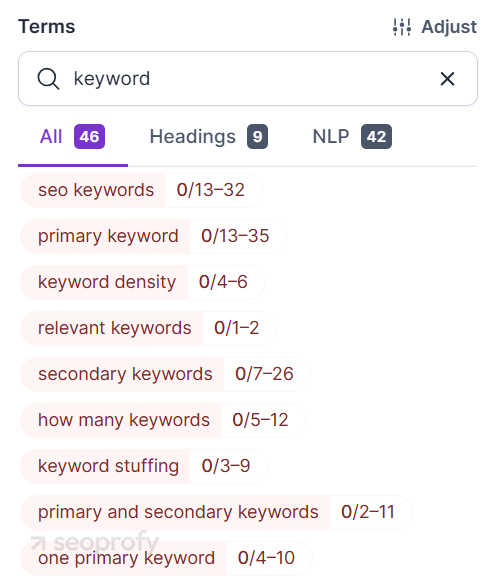
If you wonder, “How many SEO keywords should I use?” the ideal keyword density is below 3% in most cases. This way, your content stays easy to read while still signaling to search engines what your page is about.
Our expert keyword research pinpoints exactly what your audience is searching for. We’ll create content that drives real results:
- Increased organic traffic from the right audience
- Better conversion rates
- Enhanced brand authority in your industry

Where to Use Keywords
Once you know approximately how many keywords to use for SEO, let’s discuss their placement, as this makes a difference for SEO, too. Here’s where to put your target terms for the best effect:
- Title or H1: This is one of the most important spots for your main keyword. Make sure to include just one primary keyword in your headline, preferably near the start. It tells both search engines and visitors about your page’s content.
- One H2 header: Subheadings give you another chance to include your main ranking phrase or a close variation.
- First 10% of your content: Try to include your keyword early on — usually in the first paragraph. When Google sees your target term quickly, it can better understand what your page is about and rank it accordingly.
- Two to three times throughout the text: Consider also inserting your primary and secondary keywords a few more times in your writing. You should make sure they fit smoothly into your sentences and don’t sound forced.
- Meta description: This short summary appears in search results. Adding one keyword here doesn’t directly boost your rank, but it can grab people’s attention when they see it and encourage more clicks.
- URL slug: Clear URLs help both people and search engines understand what the page is about, even before they click. Instead of something vague like “website.com/page54392,” go for “website.com/your-keyword.”
- Image alt tags: Remember to add relevant keywords to your image alt text, especially if you run an online store. This increases your chances of appearing in image search results related to your products.
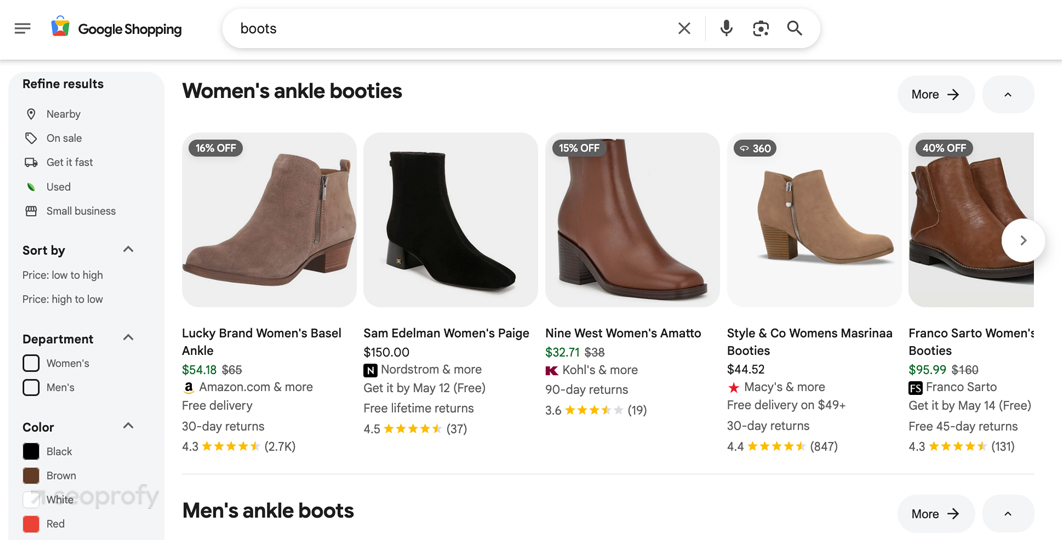
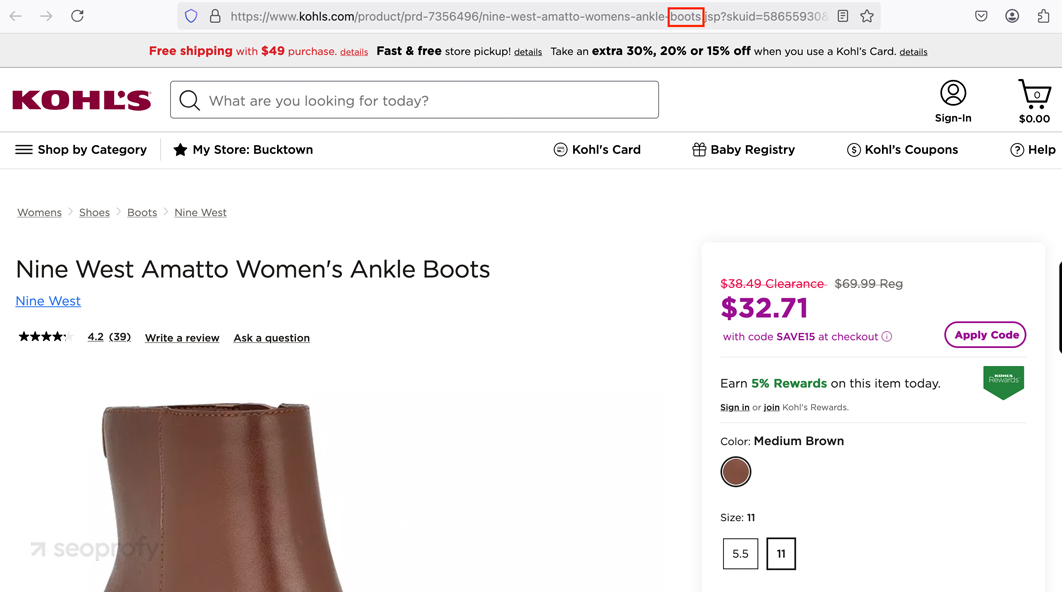
Keyword Cannibalization
This is another issue to be aware of when you plan your keyword strategy. It happens when you have several pages on your site, and all of them try to rank for the same target term. As a result, your authority is divided, which hinders the performance of any of them.
Here’s how to fix keyword cannibalization:
- Create a content map: Identify which search term each page should target, so there’s no overlap. This way, each single page will have a unique purpose.
- Combine similar content: If you have multiple pages that cover the same topic, merge them into a single, in-depth article. This consolidates your ranking power.
- Set up redirects: After combining content, redirect the old URLs to your new page. This passes the ranking strength to your preferred page.
- Use internal linking wisely: Link from less important pages to your main page on a topic. This is how Google understands which page you consider most valuable.
The Best Keyword Research Tools
Now that you understand how to use keywords effectively and avoid common pitfalls like cannibalization, you’ll need the right tools to discover the best keywords for your strategy.
Here are some of the most powerful free options:
- Google Keyword Planner is a keyword researcher tool that provides search volume ranges and competition levels directly from Google’s data.
- Google Search Console shows what terms you’re already ranking for and their click-through rates. This helps identify opportunities to improve existing content.
- AnswerThePublic visualizes questions people ask about your topic, organized by question words (how, what, when, where, which, who, why, will, are, can).
Some keyword research tools, although mostly paid versions, can do much more than just show search volumes. They can reveal user intent, related topics, and even content gaps your competitors have missed. Here are some of the best SEO tools that make it possible:
- Semrush is a comprehensive digital marketing tool that shows not just keywords, but what your competitors rank for and content gaps you can take advantage of. Plus, the platform comes with backlink profile analytics, so you can also use Semrush for many other SEO purposes.
- Ahrefs will be a great option if you are looking for a solution for in-depth competitor analysis. Below, you can see the Ahrefs dashboard that displays data on the keyword “real estate lead conversion strategies.” It lists the pages that rank most successfully for this keyword, the pages’ word count, the number of backlinks, and more:
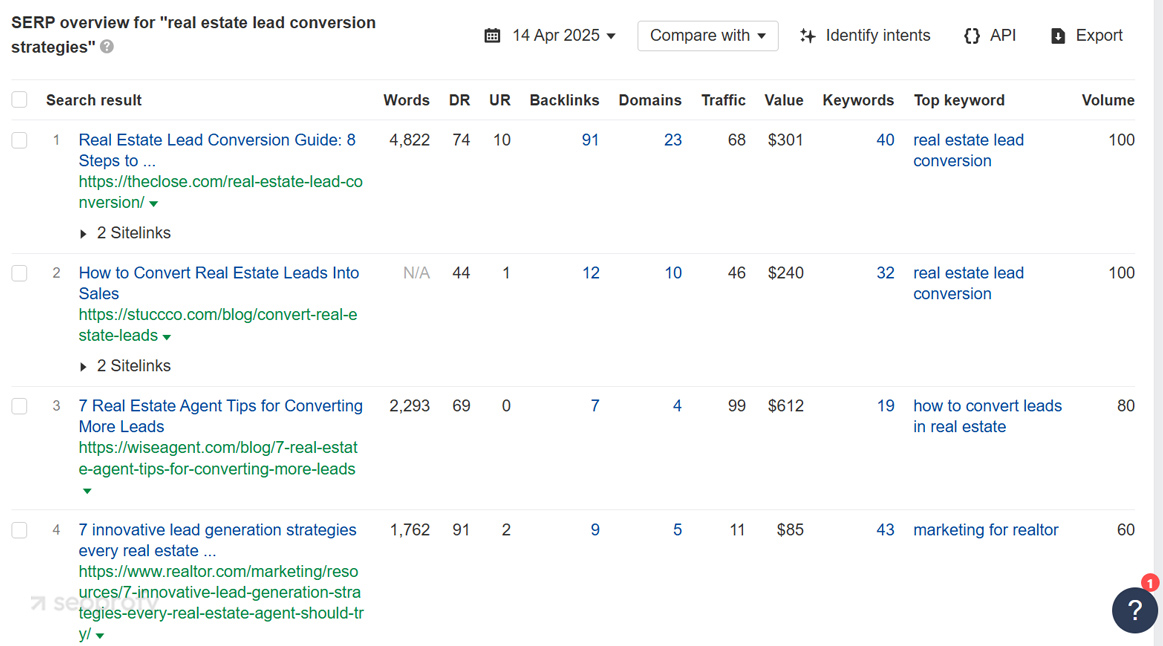
- Mangools KWFinder offers useful features at a more budget-friendly price. It’s particularly good at finding low-competition keywords for which you can rank.
However, even with the most sophisticated tools, keyword research can be challenging and may not bring the desired results if you’re new to SEO. It may not always be easy to recognize when high traffic keywords are too competitive, even if they seem promising. Plus, it’s necessary to keep in mind niche-specific nuances, as each industry has its own unique language, buyer journey, and search behavior.
Opt for keyword research services by SeoProfy. During the years of practice, we’ve established a working strategy that allows our clients to rank higher and convert better.
The Reasons Your Page Still Ranks Low
Even if you seem to do everything right and have incorporated keywords naturally, Google Analytics or other tools for measuring SEO performance still may not show progress in your rankings and traffic.
Almost 21% of SEO experts identified “SEO is about keywords” as the biggest misconception in search engine optimization. Indeed, the matter is that SEO is a complex matter, and along with keyword relevance and density, you should also check the following aspects:
- The right intent: You might target the right keywords, but if your content doesn’t match user intent, it will unlikely rank well. Evaluate the top results for your target terms and determine whether they’re in the in-depth guides, product pages, or comparison posts. If your copy’s format doesn’t align with the formats of these top pages, Google might not give it a high position.
- Content quality: If your content is thin, unhelpful, or just surface-level, it probably won’t rank much, either. The copy that succeeds aligns with Google’s guidelines called E-E-A-T (Experience, Expertise, Authoritativeness, and Trustworthiness).
- On-page optimization: Sometimes, it’s not just about what you write but how it’s organized. It’s worth reviewing your headings, image descriptions (alt text), internal links, and schema markup to make sure everything is SEO-optimized.
- Tech errors: Problems with your website’s tech setup can harm your rankings even if your content is great. Slow load times, mobile-friendliness issues, crawl errors, and duplicate content all send negative signals to search engines. Consider running technical audits with tools like Google Search Console to spot and fix these.
- Competition level: Some search terms are just more competitive than others. Newer or smaller sites often find it hard to rank for high-volume keywords that big, established sites dominate. A smarter strategy is to start by targeting less competitive keywords and focusing on quality content and natural backlinks.
Summary
The number of keywords you should use depends on multiple aspects, and the main ones are content format and length, topic complexity, and the right understanding of search intent behind a target phrase.
At SeoProfy, we know how to choose the right number of SEO keywords to make your pages visible to search engines while keeping them readable. When we’re conducting keyword research and optimizing content, we take into account every detail that might affect your rankings. We analyze your competitors and study your audience’s specific search behaviors. Just check out our SEO case studies — they show how comprehensively we treat each of our projects.
Contact us today, and our experts will develop a customized strategy with the best SEO keyword practices!








